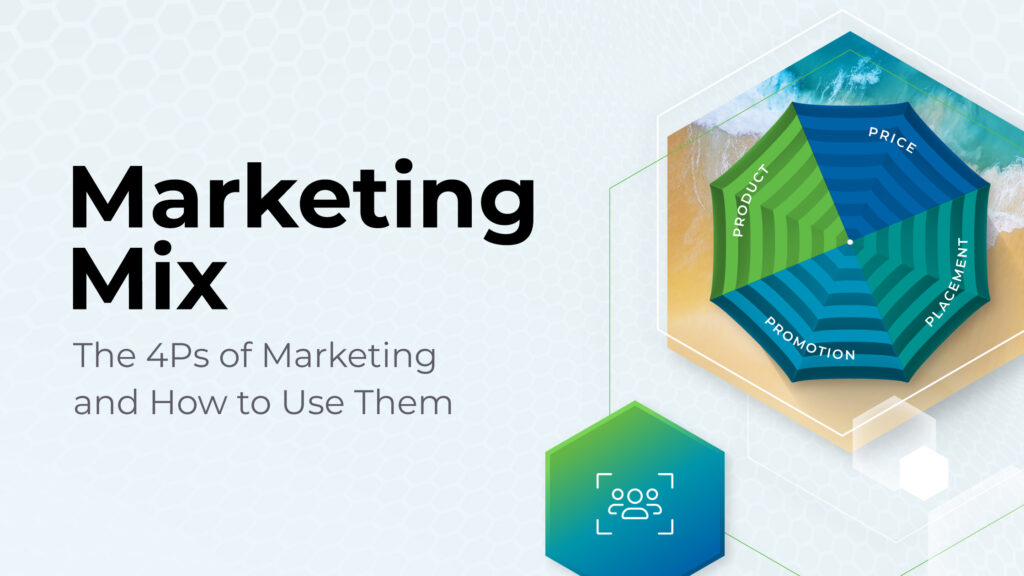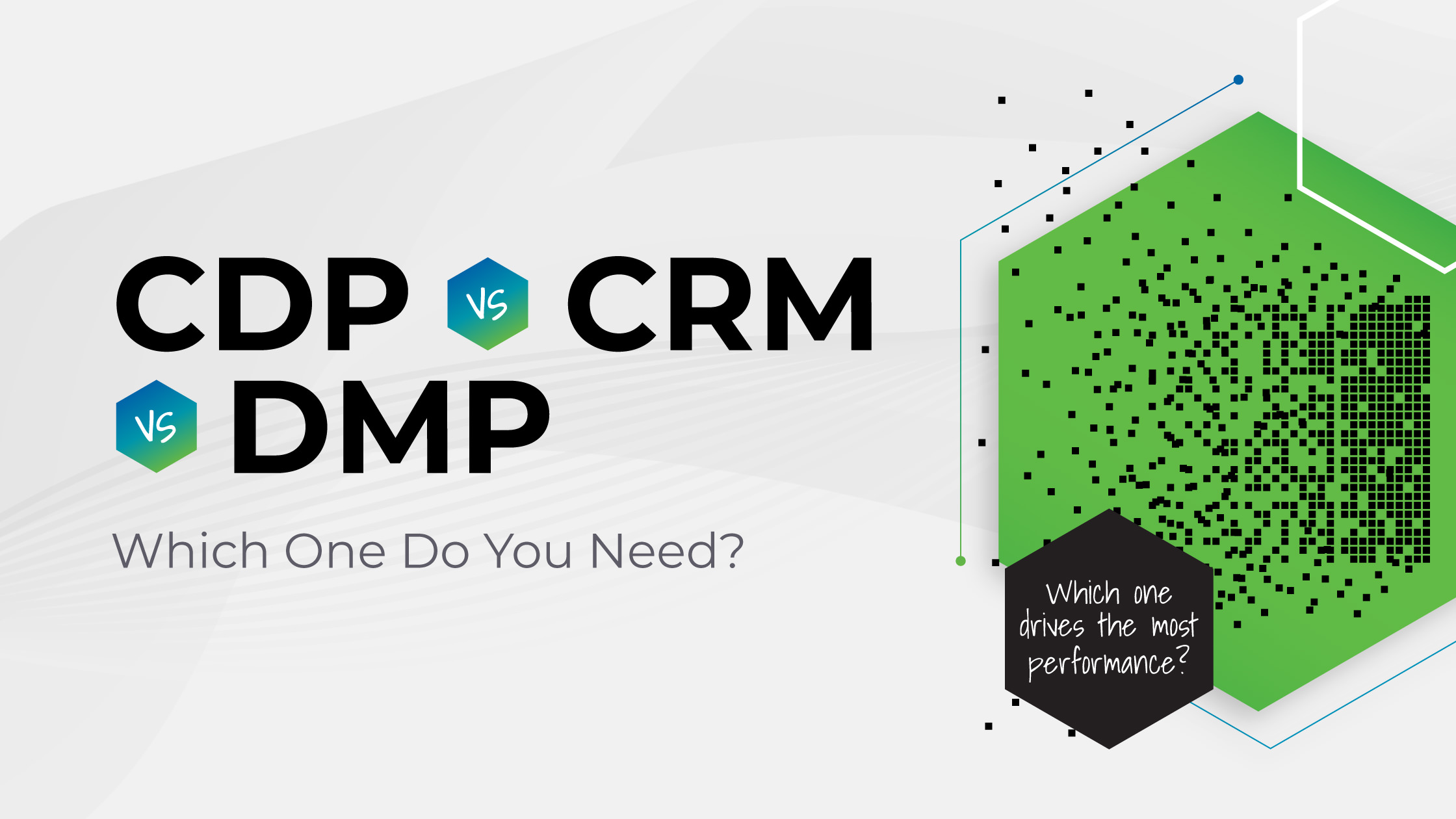
Are you practicing agile marketing or still following the traditional approach? Not sure? Then this blog post is for you.
We’re an agile marketing collective with this strongly-held opinion:
Embracing agile marketing requires a deliberate philosophical and structural pivot, which means putting aside any ego attachment to “how we’ve always done it” or “I’m super experienced so I know best” thinking.
Today’s marketing success requires leaders who are self-reflective and willing to practice beginner’s mind. Wait, growth marketing requires emotional growth? You bet it does.
Let’s unpack why traditional vs agile marketing are actually two vastly different ecosystems, and why the latter is hollering for you to come over to their side of the street. We’re covering:
- What is agile marketing?
- What is the Agile Marketing Manifesto?
- What does ‘post-linear world’ mean?
- What are the risks of choosing traditional vs agile marketing?
- 2 agile digital marketing mini case studies from our client-partners
- 6 agile marketing frameworks to consider
What is agile marketing?
The term ‘agile marketing’ refers to the process of deploying marketing resources in alignment with the core principles of agile software development. Blending agility principles with marketing fundamentals looks like:
- Flexibility on steroids
- Collaboration in practice, not just name
- Putting the Customer/Client at the center of every decision
Here’s how an agile marketing team structure functions:
Step 1: Clean up your data
Most marketers think they’re making data-driven decisions. Unfortunately, most brands and their client-agency collaborations are characterized by:
- Siloed data that lacks adequate context
- Critical marketing analytics connections are broken and no one has a clue
- Poor data governance, resulting in data inaccuracies and serious compliance exposure.
Your To-Do List
- Conduct an analytics audit to confirm that you’re actually tracking what you should be.
- Customize your marketing dashboard so that all decisions are made by referencing this ONE source of truth that integrates all data streams.
Marketing Dashboard Truths You Need to Hear, Examples, Tools & More
A marketing dashboard is the best way to visualize performance and ensure ROI. Come check out our examples, tools, and tips for avoiding common dashboard mistakes.
Step 2: Cross-functional teams
The siloed data we mentioned above is a mirror of the siloed team structure that still defines most organizations.
A lack of transparency and genuine collaboration causes siloed teams to misunderstand how an action they’re taking can cause upstream and downstream impact throughout the organization – often to the business’ detriment.
In an agile marketing process, the benefits of cross-functional marketing teams are fully leveraged. Team culture and structural norms evolve to increase cohesion between Strategy, SEO, Creative and Content, Analytics, IT and Web Development, Finance, and all other specialists.
Your To-Do List
- Review your organizational chart and collaboration guidelines (or create them).
- Conduct a performance audit to identify gaps in the team’s systemic understanding.
4 Essential Website Stakeholders for Organizational Alignment
Stakeholder alignment in any website project is a MUST. Get our tips and recommended questions to achieve alignment between marketing, IT, security, and finance, so you can safeguard revenue and sensitive customer data.
Step 3: Customer journey map
“Put the customer first” has been shouted across the marketing landscape for decades. However, most brands haven’t used reliable data to define who their customer is, what they want, and when and how they want it.
The one-size-fits-all approach to marketing is dead. Meeting individual customer needs and preferences requires personalization, segmentation, and the continuous gathering of customer feedback and insights.
Every campaign and piece of content should emerge from your customer journey map – a dynamic document that evolves periodically because customer behavior will vary as market conditions change.
Your To-Do List
Run, don’t walk, toward creating a data-centric customer journey map.
How To Map Your Customer’s Journey
Explore our comprehensive guide on creating customer journey maps. Learn practical steps to understand and enhance your customer’s path.
Agile marketing is a mindset that requires an updated team ethos.
The agile marketing methodology is a thought model and set of practices that allow marketing teams to be more responsive, customer-focused, and nimble in the fast-paced and ever-changing business landscape.
The way your marketing team thinks about their work needs to evolve.
Some of the defining mindset shifts required by agile digital marketing are:
- Flexibility and adaptability. Who cares if we planned X last quarter? What does the data say now? High-performing agile teams embrace change, practice marketing flexibility, and are willing to pivot on a dime.
- Incremental improvements. Marketing projects are broken into smaller tasks. Teams work on these iterations with a focus on continuous marketing improvement. All processes and outcomes are regularly analyzed to find ways to increase effectiveness over time.
- Transparent communication. We mentioned this above, but it might be the core of it all so it bears repeating. Open and frequent communication within teams and stakeholders is crucial. Regular stand-ups and post-mortems keep everyone aligned.
- Prioritize the Test-and-Learn Approach. Tasks are prioritized based on value and impact. A/B testing and experimentation are daily practices used to validate assumptions and zero in on nuances in customer behavior, which then informs strategy adjustments.
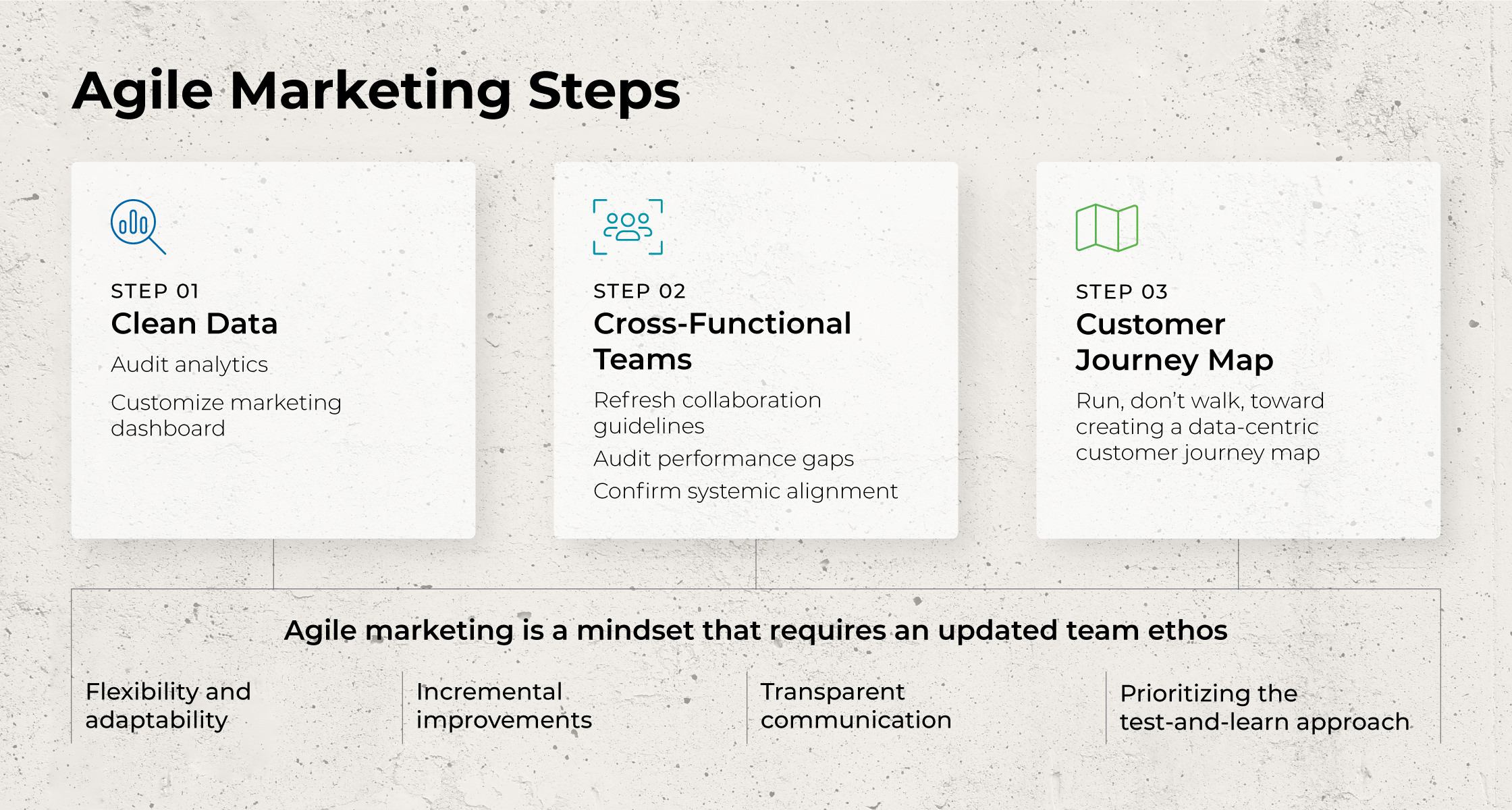
The Official Agile Marketing Manifesto
We appreciate a short n’ sweet manifesto and that’s precisely what the Agile Marketing Manifesto is. It contains five key elements:
1. Focus on customer value and business outcomes, over activity and outputs.
2. Deliver value early and often, over waiting for perfection.
3. Learn through experiments and data, over opinions and conventions.
4. Cross-functional collaboration, over silos and hierarchies.
5. Respond to change, over following a static plan.
Marketing Mix: The 4Ps of Marketing & How to Use Them
Learn more about the marketing mix, or the 4Ps of marketing. Discover examples and how to use them in your marketing strategy.
What is post-linear marketing?
‘Post-linear marketing’ refers to the shift away from traditional, linear marketing models toward more dynamic and nonlinear ways of engaging with a brand’s key audiences.
The traditional marketing model assumed a linear progression from Awareness to Consideration to Purchase. Customer behavior and its associated marketing activity was conceptualized in a simplistic, one-dimensional fashion. This approach made a lot of people a lot of money. But…
The linear approach to marketing doesn’t work anymore.
The consumer journey has become more complex and nonlinear, because of things like:
- Widespread access to information and research sources has evolved how consumers engage with content and make buying decisions.
- Consumers want a seamless multichannel marketing experience, whether interacting with your brand’s website, social media channels, email marketing, or native app.
- Interruption-based advertising is less prevalent and less effective where it’s still available, because consumers have developed ad avoidance/ad blindness.
- The death of third-party cookies, coupled with the prevalence of ad blockers, hinders the effectiveness of traditional advertising tactics.
- Many brands were told to ignore the competition. Terrible advice. The competitive landscape is more dynamic than ever, with disruptors galore.
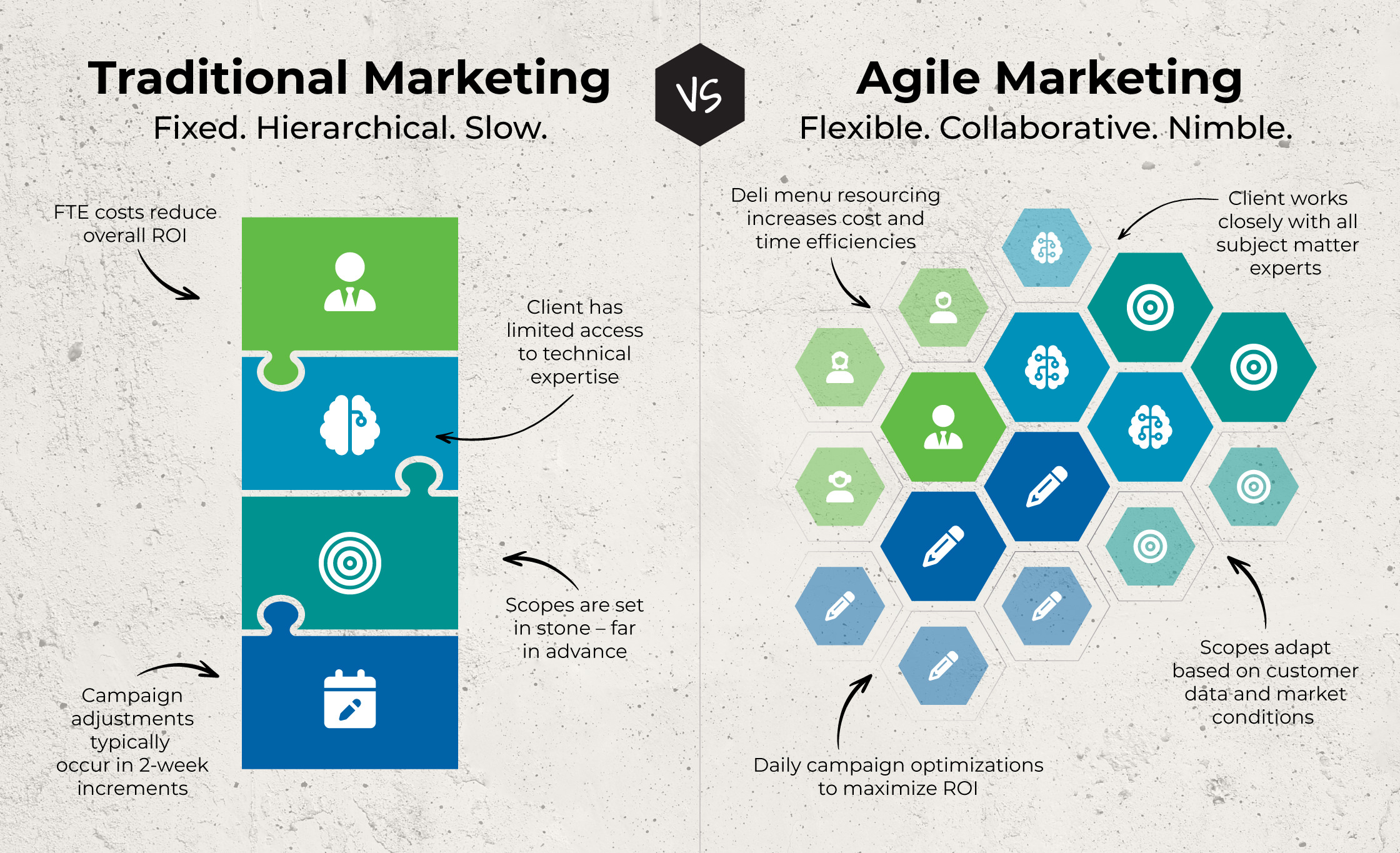
What are the risks of choosing a traditional vs agile marketing partner?
Marketing leaders are accountable for generating ROI for their brand. The biggest risk of traditional marketing, as mentioned above, is the loss of marketing ROI. And yet, this is exactly what has been normalized in traditional agency-client relationships.
- FTE (full-time employee) model passes a portion of their large staffing costs onto clients.
- Client access is restricted to an Account Manager or small percentage of the technical specialists doing the actual work.
- Traditional performance agencies scope whole quarters or a year of marketing activity well in advance and follow through no matter what, despite fluctuations in market conditions.
- Most agencies monitor campaigns every 2-3 weeks or at the very end of the campaign, which misses the opportunity to make on-the-fly optimizations.
Brands in growth mode, following the traditional/linear marketing model, are missing out on a tremendous amount of opportunity.
In an agile marketing approach, channels are optimized constantly – not twice a year.
And a collaborative team of marketing experts regularly comb through essential data points to identify where and how the brand can acquire more fruitful gains with greater efficiency.
Agile vs traditional marketing is not simply a matter of personal preference – it’s the difference between sustainable businesses and dying ones.
Agile marketing case studies
Client-Partner: High-end CPG (consumer packaged goods) brand
In May 2023, our client-partner gave us the following three-part mission critical task:
- Increase net new customers
- Increase top-line revenue
- Achieve ROAS of at least 2X
We took swift action, immediately pivoting our optimization strategy to focus on aMER. With this, we generated performance improvements week over week, which results in substantial ROAS improvements in just seven months.
The results
- ROAS in May 2023: 1.47X
- ROAS in Nov 2023: 3.4X
- ROAS Growth: 126% improved in less than 7 months
- Top-line Revenue Growth: 10%
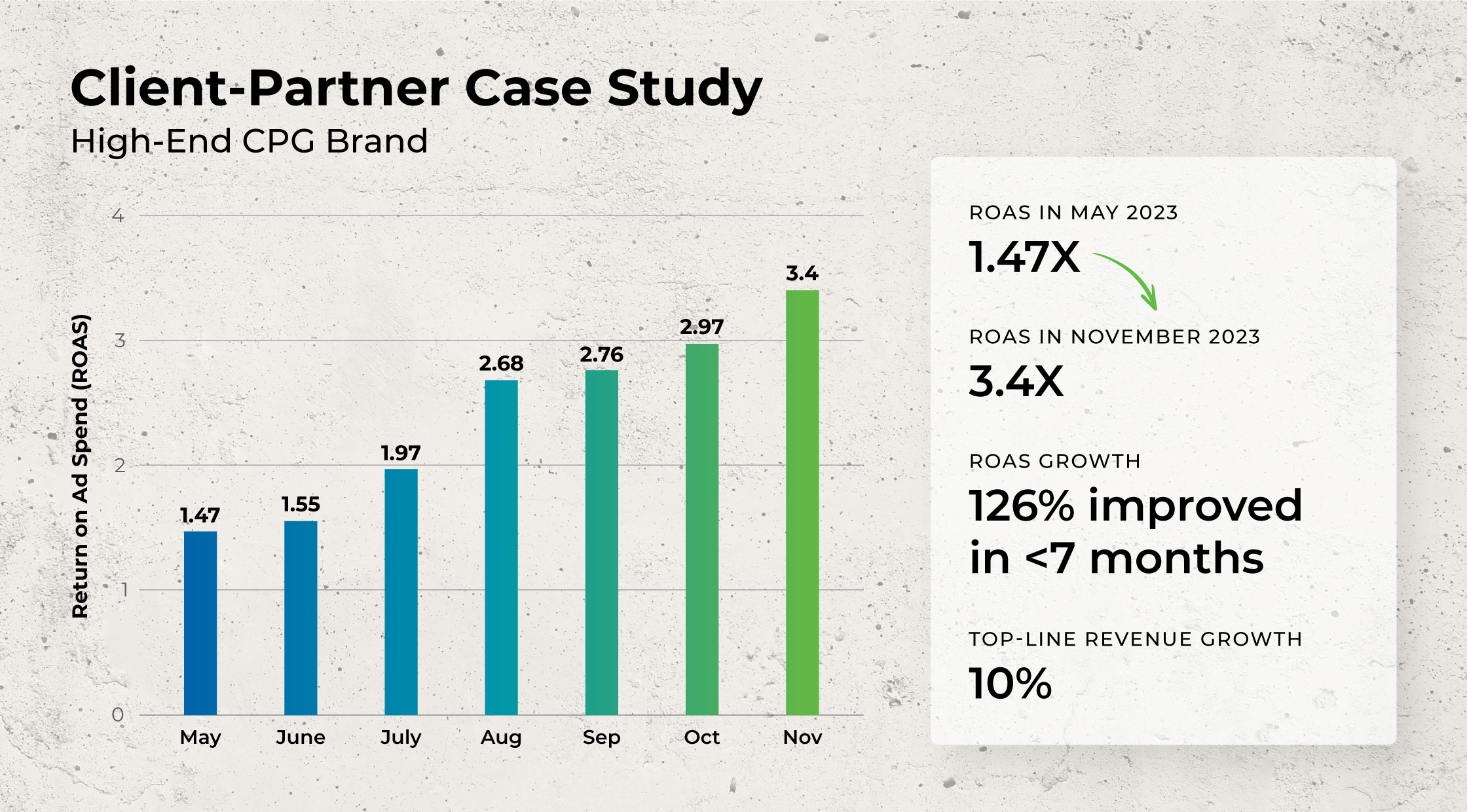
How did agile marketing support these client-partner results?
- Speed. Did it take 18 rounds of meetings to debate this strategy vs that one? Definitely not. Leadership was clear on the critical needs of the business, which allowed their Apiary Performance Marketing Team to align on the top priorities and get going. Fast.
- Data-driven actions. Common sense says revenue should be the primary number to track in any business, right? Undoubtedly, it’s an essential metric, but marketing math shows that additional metrics, like Marketing Efficiency Ratio (MER), are equally relevant.
- Continuous improvements. Weekly (often daily) campaign monitoring allowed our team to identify opportunities for improvements, and that iterative process continued week after week. Test + Learn + Leverage your learnings. On repeat.
How to Measure and Improve Marketing Efficiency Ratio (MER)
Ready to improve your marketing efficiency ratio (MER)? Our experts explain what MER stands for, how to calculate it, and what a good MER looks like. Check it out!
Client-Partner: Prestigious education institution
We were tasked with helping the executive education program of a renowned university market their hybrid approach to education in a post-Covid world.
We implemented a multifunctional strategy (Google, LinkedIn, and Meta) that spanned everything from top-tier awareness to driving conversions directly into their pipeline.
The results
- January – July 2022: $277K in revenue and 1.5X ROAS
- January – July 2023: $449K in revenue and 3.6X ROAS
- Revenue increased by 62%
- ROAS increased by 140%
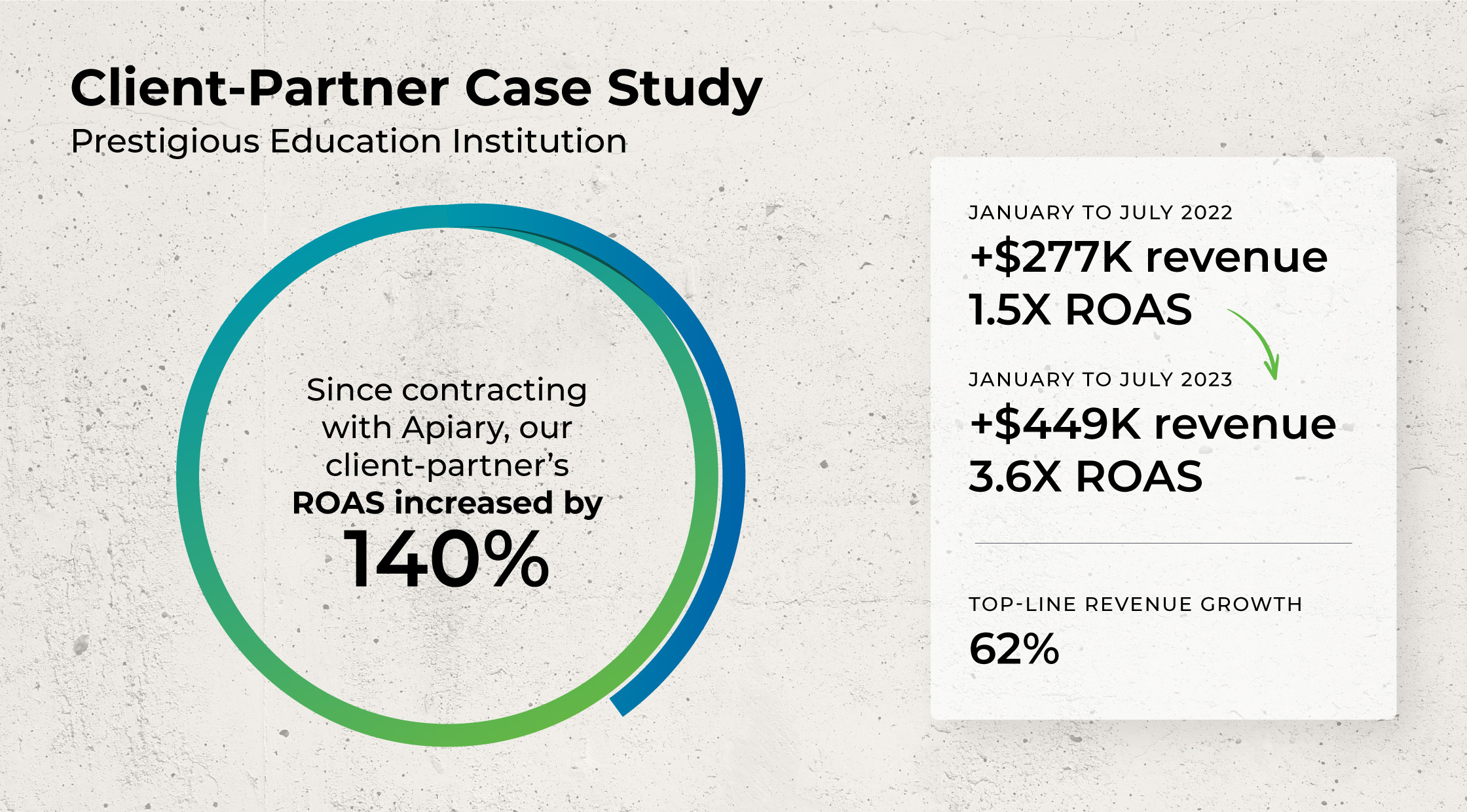
Note: Revenue gains mentioned above are only what can be directly attributed to our work, but let’s not forget the substantial local and national brand awareness generated by our campaigns.
Demand has been so strong that the program has had to implement class waitlists for the first time since the start of the pandemic, and are on track for a fully booked class roster in 2024.
How did agile marketing support these client-partner results?
- Speed. We created an agile media plan that was fully customized for the needs of our client-partner, and implemented it right away. Cumbersome processes and rigid hierarchies would have made this impossible.
- Data-driven performance decisions. Agile marketers know that revenue is not always the most important KPI. For this client-partner, analyzing and optimizing for ROAS improvements was a more relevant goal than simply striving for revenue gains. Agile marketing is about understanding the intended destination and then making data-informed decisions every step of the way.
6 agile marketing frameworks to consider
There are several agile marketing frameworks, each with pros and cons depending on an organization’s size, culture, and marketing priorities. We’ve used them all, and often combine elements of several methodologies to create a customized experience for client-partners.
Here are 6 of the most common agile marketing frameworks:
Scrum
Scrum marketing is the most well-known agile framework. It involves time-boxed “sprints” that usually last two to four weeks, daily stand-ups, sprint planning, sprint review, and retrospective meetings.
Kanban
Another popular choice, Kanban uses boards to visualize work. This framework emphasizes limiting work in progress (WIP) and continuous improvements.
Lean
Lean principles, drawn from Lean manufacturing, focus on reducing waste, maximizing value, and continuous improvement.
SAFe (Scaled Agile Framework)
SAFe is an agile framework designed for large organizations and enterprises looking for a structured approach to aligning strategy, execution, and delivery across multiple teams.
Scrumban
As its name suggests, this hybrid approach merges Scrum ceremonies and roles with Kanban’s visual workflow and work-in-progress limits.
Agile Results Framework
Using a highly structured approach to setting and achieving outcomes, this framework defines clear objectives, key results, and daily, weekly, and monthly rhythms for tracking progress.
TL;DR on Agile Marketing in a Post-Linear World
- Agile marketing is a set of practices designed to facilitate a flexible, data-driven, and highly collaborative approach to the deployment of marketing resources.
- Post-linear marketing refers to a more dynamic and nonlinear approach to acquiring and retaining customers.
- Traditional marketing generally locks marketing efforts into fixed boxes and lacks the skill and willingness to quickly adjust to fluctuations in customer behavior.
- Agile marketing prioritizes clean data (most brands are unknowingly operating with unreliable metrics), continuously updating the customer journey map, and making performance optimizations at every turn.
- 6 of the most common agile marketing frameworks are Scrum, Kanban, Lean, SAFe, Scrumban, and the Agile Results Framework.



